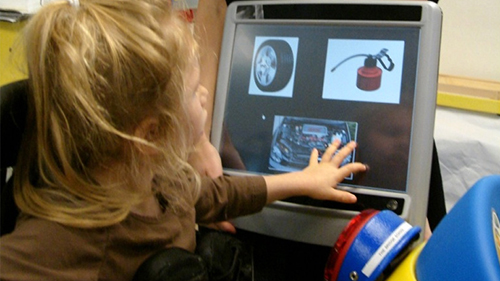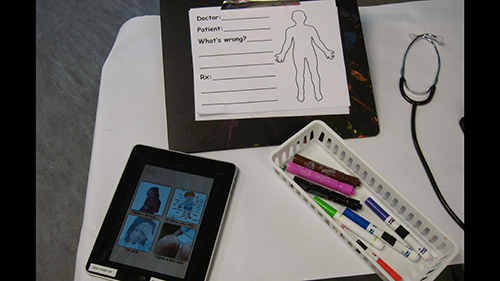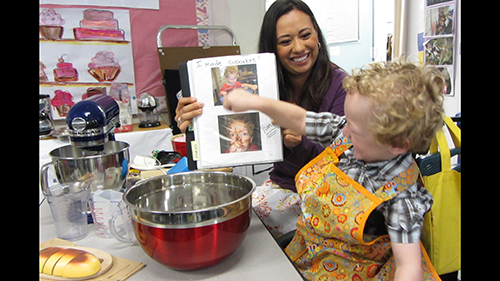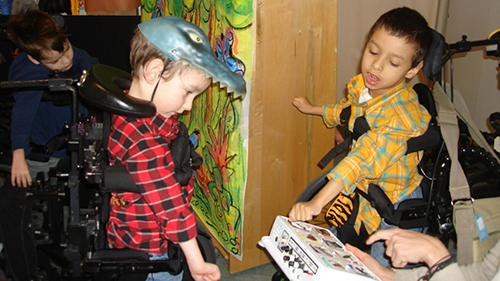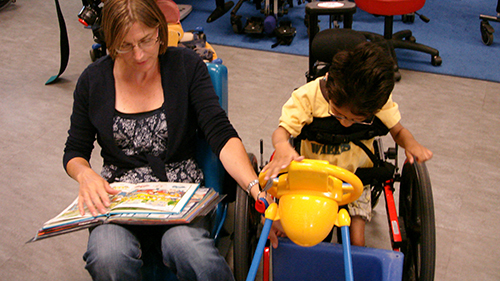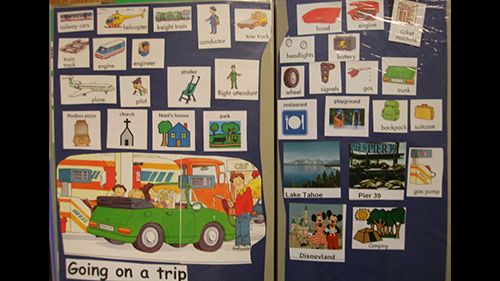Pretend Play
“Play is possibly the most important and natural context for language learning and language instruction. It is not only a source of pleasure for young children, but also a way to learn and practice new behaviors. Children experiment with life experiences when they play, constructing their understanding of objects and events and learning how to talk about them” (McCormick 2003).
Child-centered, thematic play activities are central to The Bridge School’s Preschool Program. Preschool play centers are arranged so students have access to props and a range of communication tools designed to support their participation in play scenarios. Classroom staff use interaction strategies to support communicative competence skills. During pretend play, for example, students direct their own learning and adults carefully follow the attention and interests of the child while creating opportunities to develop the students operational, strategic, social and linguistic competencies.
Operational Competence Skills
Activate a single switch to operate toys, music, other errorless cause and effect activities.
Demonstrate motor control for direct selection of increasingly smaller targets, within increasingly larger arrays.
Speech-generating devices (SGDs) are incorporated into play centers. Here, Abigail touches pictures to tell what she wants to do next to fix the car during the ‘Transportation’ play theme.
Seek out communication tools/system for use.
Different communication tools are arranged in pretend play centers along with toys and props so that students gain experience with a variety of tools for different purposes.
Strategic Competence Skills
Ambulate towards preferred objects and activities.
In his hands-free walker, Roman can go to the fire truck to let us know he’s ready to play firefighter.
Use mementos or remnants to bypass vocabulary limitations and establish topics of interaction.
Jet is reenacting something he did at home during the ‘Bakery’ theme, and using his low-tech communication book to say ‘I made cupcakes!’
Social Competence Skills
Participate in simple games with peers by communicating a desire using a reliable response (looking, touching, saying a word with speech or SGD).
Demonstrate turn-taking during social interactions, social action games, songs, etc.
These preschool students negotiate and act out the roles of jungle animals and safari-goer while playing ‘Jungle Safari.’
Use natural behaviors or gestures to indicate social attention and interest in peer communication partners.
In child-directed play activities, we can follow Adam’s lead and reinforce his communicative signals as he indicates his interest in what peers are doing.
Linguistic Competence Skills
Demonstrate comprehension of vocabulary within familiar routines and lessons.
Express concepts using representational strategies.
Elisa supports Joey’s language development during the ‘Transportation’ theme with low-tech communication tools.
References
Bunce, B.H. (2008). Early literacy in action: The language-focused curriculum for preschool. Baltimore: Paul H. Brookes Publishing Co.
McCormick, L. (2003). Language Intervention in the Inclusive Preschool. In Supporting Children with Communication Difficulties in Inclusive Settings: School-based Language Intervention. 2nd Edition. McCormick, L., Loeb, D.F., & Schiefelbusch, R.L. (Eds). Boston: Allyn and Bacon.



